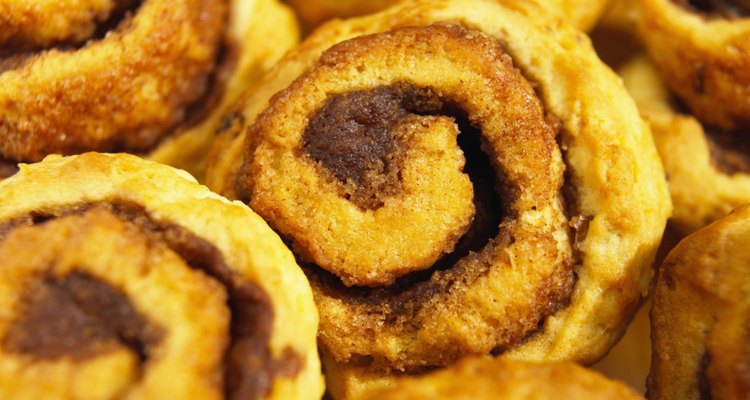
Purestock/Purestock/Getty Images
You can flavor yeast breads by adding a pinch of your favorite spice or herb. Herbs -- from the leafy portion of a plant -- and spices -- which come from any other part of the plant -- can be mixed with the dough at any stage of the baking process, or they can be sprinkled on top just before baking. Some herbs and spices increase yeast development and growth, while others inhibit yeast development. In some cases, whether herbs and spices affect yeast growth or not depends on the amount you use.
Benefits of Enhancing Yeast Activity
Increased yeast activity means more gas is produced as the bread is kneaded and left to rise. As a general rule, the more gas that is present, the better the overall flavor and structure of the bread. Increased gas activity often leads to lighter, fluffier breads; however, breads that rise too quickly can become sour, and their flavor is not as well-rounded. Careful, controlled yeast development is important for well-structured, flavorful breads. Because of this, carefully follow the quantities recommended for your recipe. If you want to increase flavor in your bread, consider sprinkling the herb or spice on just before baking, such as scattering rosemary leaves or caraway seeds on the top of a loaf.
Enhance Yeast Development
Spices and herbs that encourage yeast growth include rosemary, fenugreek, oregano, cumin, sage, cardamom, ginger, nutmeg and thyme. These herbs and spices are often added to herbed or Middle Eastern breads. While many herbs and spices have natural antimicrobial properties, in small amounts, they encourage acid and gas production in bacteria in yeast-raised breads.
How Much to Use
In general, 1/10 to a 1/2 gram of herb or spice per gram of yeast encourages yeast development in breads. Even if a spice or herb doesn’t limit yeast development, too much of an enhancing ingredient can actually lead to less overall yeast growth. When adding more than 1/2 gram of herb or spice per gram of yeast, yeast activity drops significantly; even if in small amounts, the spice encourages yeast growth. When you use a spice like cinnamon, a gram of spice per gram of yeast can lead to negative yeast development.
Limit Yeast Development
Some herbs and spices limit the development of yeast, namely mustard, but also members of the allicin family, including chives, onions and garlic. To compensate for the lower yeast activity in breads that include these seasonings, increase the amount of yeast used by about a 1/4 teaspoon per 1/2 teaspoon of seasoning. You can also add the herbs and spices after the bread has risen a second time to minimize the effect the spices have on yeast production.
Related Articles
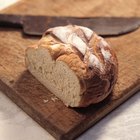
Does Heat Kill Lactobacillus Bacteria ...
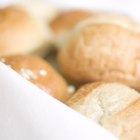
How to Make Yeast Rolls More Flavorful

What Is Artisan Bread?
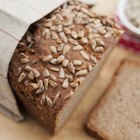
Russian Rye Bread vs. Pumpernickel

Can I Exchange Cinnamon for Allspice?
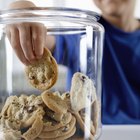
Can Humidity Affect Cookies?
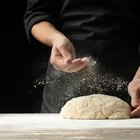
How to Increase the Yeast Taste in Bread
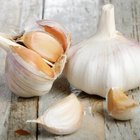
How to Get Rid of Garlic Body Odor

How to Make Bread Chewy

Does Yeast Cause Holes in Bread?

How to Make Bread Tender

How to Eat Fennel Seeds

Can You Refrigerate Homemade Yeast ...
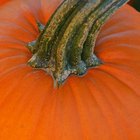
How to Make Pumpkin Bread Moist

What Happens When Vinegar & Yeast Are ...

Why Does Bread Drop in the Middle When ...
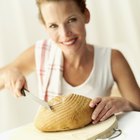
How to Bake Bread in a Dutch Oven
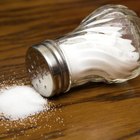
How to Find a Salt Substitute Without ...

Can I Substitute Bleached for ...

Can You Substitute Yogurt for Milk in ...
References
Writer Bio
David Grimes has worked professionally as a chef since 2002, in settings as wide-ranging as a corporate caterer and as a sous chef in a Michelin-starred French restaurant. He has been writing about food since 2009 and published in "Time Out New York" and "Food and Wine" magazine.
Photo Credits
Purestock/Purestock/Getty Images